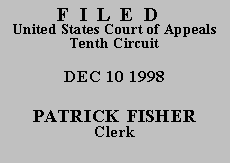 UNITED STATES COURT OF APPEALS
UNITED STATES COURT OF APPEALS
 UNITED STATES COURT OF APPEALS
UNITED STATES COURT OF APPEALS
TENTH CIRCUIT
| BARRY R. MCCLURE, | |
| v. | No. 98-6268 |
| STEVE HARGETT, | (D.C. No. 97-CV-1417) |
ORDER AND JUDGMENT(*)
Before SEYMOUR, BALDOCK, and HENRY, Circuit Judges.(**)
Petitioner Barry R. McClure appeals the district court's order dismissing his 28 U.S.C. § 2241 petition for a writ of habeas corpus as time-barred under the one-year statute of limitations contained in the Antiterrorism and Effective Death Penalty Act of 1996, Pub. L. No. 104-132, § 101, 110 Stat. 1321 (codified at 28 U.S.C. §§ 2244(d)(1) - (d)(2)). Specifically, Petitioner argues that the district court erred by failing to toll the limitations period while the Oklahoma state courts considered his requests for post-conviction relief. Our jurisdiction arises under 28 U.S.C. § 1291. We conclude the district court should have tolled the limitations period while Petitioner sought state post-conviction relief. Accordingly, we reverse and remand.I.
On April 24, 1996, Congress enacted the AEDPA, which established, inter alia, a one-year period of limitations for habeas petitions. 28 U.S.C. § 2244(d)(1). The limitations period generally begins to run on the date the petitioner's direct criminal appeal becomes final. 28 U.S.C. § 2244 (d)(1)(A). Where a prisoner's direct appeal becomes final before Congress enacted the AEDPA, however, courts have recognized a one-year "grace period" in which prisoners may file a habeas petition. E.g., Burns v. Morton, 134 F.3d 109, 111 (3d Cir. 1998). This "grace period" begins to run on April 24, 1996 and ends one year later. The statute itself further softens the effect of the limitations period by providing that "[t]he time during which a properly filed application for State post-conviction or other collateral review with respect to the pertinent judgment or claim is pending shall not be counted toward any period of limitation under this subsection." 28 U.S.C. 2244(d)(2).
The pertinent facts are undisputed. Petitioner is in custody pursuant to a state court judgment. Petitioner's direct appeal became final before Congress enacted the AEDPA. Petitioner filed an application for post-conviction relief in state court before the limitations period expired. Petitioner's state-court proceeding ended after the limitations period expired, and Petitioner filed the instant § 2254 motion in the district court four days later.
II.
We now turn to the issue before us; whether the district court erred by failing to apply § 2244(d)(2)'s tolling provision for the amount of time Petitioner spent seeking state post-conviction relief. On the facts of this case, the answer is yes.(1)
In Hoggro v. Boone, 150 F.3d 1223 (10th Cir. 1998), we examined the precise issue presented in this case. There, the petitioner sought post-conviction relief in state-court, and while the proceedings were pending the AEDPA's one-year limitations period expired. After the state court denied the Petitioner's request for relief, Petitioner filed a 28 U.S.C. § 2254 petition for a writ of habeas corpus in federal district court. The district court dismissed the petition as time-barred under the AEDPA. If the district court had tolled the limitations period under § 2244(d)(2), however, the petition would have been timely.
Examining the statutory language, we determined that "§ 2244(d)(2) requires federal courts to toll time spent in state-court post-conviction litigation." Hoggro 150 F.3d at 1226. "Applying this understanding of the limitation's period in § 2244(d) to Hoggro's case, we [concluded] that his habeas petition [met] the one-year limitations period." Id. at 1226.
Hoggro clearly controls the outcome of this case.(2) Fourteen days before the one-year limitation period expired on April 24, 1997, Petitioner sought post-conviction relief in state court. The state courts denied his requests for relief after the limitation period expired. Four days after the state courts denied relief, Petitioner filed the instant § 2254 petition for a writ of habeas corpus. Section 2244(d)(2) clearly required the district court to toll the limitation period for the period in which Petitioner sought post-conviction review. Applying the tolling provision, Petitioner filed his habeas petition ten days before the limitations period expired. Therefore, his petition was not time-barred. Accordingly, we REVERSE and REMAND for further proceedings consistent with this order and judgment.
Entered for the Court,
Bobby R. Baldock
Circuit Judge
*. This order and judgment is not binding precedent, except under the doctrines of law of the case, res judicata, and collateral estoppel. The court generally disfavors the citation of orders and judgments; nevertheless, an order and judgment may be cited under the terms and conditions of 10th Cir. R. 36.3.
**. After examining the briefs and appellate record, this three-judge panel has determined unanimously that oral argument would not be of material assistance in the determination of this appeal. See Fed. R. App. P. 34(a)(2)(C); 10th Cir. R. 34.1.9. The case is therefore ordered submitted without oral argument.
1. We note that the district court did not have the benefit of our recent opinion in Hoggro v. Boone, 150 F.3d 1223 (10th Cir. 1998), when it dismissed Petitioner's request for habeas relief.
2. Respondent contends that the reasoning applied in Hoggro is faulty and suggests that we revisit the matter in this case. Absent en banc reconsideration or a superseding contrary decision of the Supreme Court, we are bound by the decision of an earlier panel. LeFever v. Commissioner of Internal Revenue, 100 F.3d 778, 787 (10th Cir. 1996). Therefore, we decline Respondent's invitation to revisit the wisdom of the earlier panel's decision.